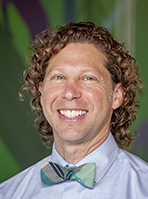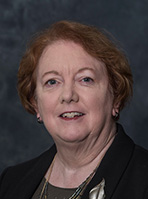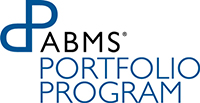
Sponsors may have signed up for the American Board of Medical Specialties Portfolio Program (ABMS Portfolio Program™) because it enables them to award physicians, and more recently physician assistants, continuing certification credit for engaging in quality improvement (QI) initiatives. What they didn’t know was just how much it would contribute to their institutions’ quality and safety culture, and even enhance physician well-being.

“It has become a catalyst to engage physicians in QI work,” stated Joel Tieder, MD, MPH, Medical Director of the Maintenance of Certification (MOC) Program at Seattle Children’s Hospital in Washington “It provides a platform for physicians to bring their ideas forward for doing meaningful QI work in their area of expertise.” At the same time, many of the QI projects align with the strategic priorities of the hospital, which has been a Portfolio Program Sponsor since 2012.
When Valley Preferred-Lehigh Valley Health Network in Allentown, Penn., became a Sponsor in February 2019, it had clear objectives. “We wanted to create an enhanced environment around QI initiatives. And we wanted a higher level of engagement and support for our clinicians’ QI work,” stated John Stoeckle, MD, CHQS, Associate Medical Director of Population Health. The current QI projects are a mix of strategic initiatives and grass roots QI projects that clinicians are passionate about, he added.
Once physicians engage in a QI initiative, they tend to increase their participation levels. Many QI project leaders have gone on to do more QI work, Dr. Tieder noted. At Valley Preferred–Lehigh Valley Health Network, two QI projects completed the first year grew to 14 the second year, and the numbers continue to rise, Dr. Stoeckle said.
Promoting a quality and safety culture

Being a Sponsor not only reinforces and promotes a quality and safety culture, it contributes to physician well-being, said Patricia Reagan Webster, PhD, Associate Quality Officer at the University of Rochester in New York. By engaging in these QI efforts, physicians receive continuing certification credit and meet other requirements for QI work. That, in turn, helps them improve patient care, prevent burnout, and create a healthy work/life balance, she added.
Similarly at Valley Preferred-Lehigh Valley Health Network, the Portfolio Program is positively impacting physician well-being “whether it’s reducing administrative burden for QI requirements or doing a specific QI project around well-being,” Dr. Stoeckle said. “For those who get more QI training, there is a sense of rejuvenation and purpose that brings new meaning to their work,” he added. That is the impetus behind a new effort to offer additional QI training to leaders who are engaged in this work to achieve a higher level of competency. “In today’s health care environment, everything we do has to create added value and even efficiencies for clinicians, and the Portfolio Program contributes to that,” Dr. Stoeckle said.
Being a Sponsor also reinforces a quality mindset beyond QI projects, noted Dr. Reagan Webster. “It’s not just that the physicians want to get better, it’s how much better, and by when,” she said.

Six years into its sponsorship, physicians at Prisma Health in South Carolina aren’t just using the Plan–Do–Study–Act (PDSA) cycle for QI projects, explained Donna Ray, MD, Director of Faculty Development in the Office of Continuing Professional Development (CPD) and Strategic Affairs. Following the Master Adaptive Learner model, the physicians are applying QI thinking to their own learning, she said.
Forging ties across the organization
Being a Portfolio Program Sponsor has forged closer collaboration between the QI department, continuing medical education (CME)/CPD office, credentialing, and information technology.
“This work has aligned us with all those areas,” Dr. Tieder said. “We share a common goal to improve physician engagement in QI as part of their everyday work. We want to make sure that we’re supporting physicians wherever they are participating in QI activities and that these activities align.” For example, the MOC Program coordinates with the medical staff to know what the physicians’ continuing certification and CME needs are and works with information technology to obtain meaningful measures for QI projects.

Such coordination is particularly helpful with larger QI initiatives, such as the COVID-19 project that had 400 participants, Dr. Stoeckle said. He worked closely with medical staff services to ensure eligibility requirements for the project designed to equip frontline clinicians with best practices and skills for having conversations about vaccinations. Dr. Stoeckle also recently partnered with the Department of Education to offer Performance Improvement-CME.
Dr. Ray has partnered a lot with the Graduate Medical Education (GME) office, offering CME and/or continuing certification credit for faculty engaged in QI projects. Her office serves Prisma Health and the University of South Carolina School of Medicine Columbia. They recently developed a learning collaborative focused on teaching QI called QUEST — Quality Education and Systems Training — for health professions students. The faculty who serve as mentors to these students are offered the opportunity to apply for continuing certification credit through the Portfolio Program.
When the health system became a Sponsor, an interdisciplinary team was formed to help structure the Portfolio Program, Dr. Ray said. It included the GME office, credentialing, and CME team. However, it was Palmetto Health, which consisted of three hospitals, that became a Sponsor in 2015, she explained. Two years later, the Palmetto Health Hospitals merged with the Greenville Hospital System in the upstate of South Carolina to form Prisma Health, the largest health care system in the state, with 30,000 team members across nine hospitals plus partnerships with the two University of South Carolina Schools of Medicine in Columbia and Greenville.
“We were gaining traction with QI efforts as Palmetto Health and then the merger happened,” Dr. Ray said. There is a new layer of centralized management and structure that took a while to form once the merger was complete. This past spring, the Portfolio Program began offering participation across the full Prisma Health System. “But it’s a journey,” she said. “We’re still building that network.”
Using valuable resources
Regarding networking, the Portfolio Program staff at ABMS host monthly calls and provide a quarterly newsletter and periodic program updates. There is a web-based tool — Sponsor Central — that enables Sponsors to have conversations and share documents. Additionally, the staff developed templates for QI activities related to COVID-19, health disparities, opioids, and telehealth, as well as revised requirements providing greater flexibility and increased innovation.

Dr. Stoeckle remains grateful to the University of Michigan for providing so much support when he was starting the Portfolio Program at his health system. Recently, he connected with Cleveland Clinic to learn more about its QI training program, something Dr. Stoeckle is looking to establish. “It’s a very collaborative community,” he said.
“Having a community of like-minded institutions to share experiences has been very helpful,” Dr. Tieder stated. When considering a new QI project, it’s beneficial to see how other Sponsors have done it. “This was especially helpful when the COVID-19 pandemic began and we had to adapt our QI efforts,” he said.
Likewise, Dr. Reagan Webster finds the calls extremely valuable, especially learning how the other Sponsors modified their processes to address COVID-19 QI work. “We had to take a little different approach than identifying a problem over time and doing cycles of improvement. We had to switch it up to more rapid changes,” she said, adding, “When the template came out, it was very helpful.”
The physicians really appreciate the templates as they cut down on paperwork, Dr. Reagan Webster noted. They also are pleased with the one-step submission process to earn credit for serving in a QI/patient safety leadership role. “Some of our leaders have been putting in an incredible amount of work during the pandemic that didn’t lend itself to the PDSA cycle. They were creating and leading new programs and changing in fundamental ways how we were delivering health care,” she continued. “They appreciate that their long hours and hard work can now be recognized through the Portfolio Program.” Additionally, many physicians spend a lot of time mentoring medical students on clinical rotation and they can now earn continuing certification credit for doing so.
“The framing of the Portfolio Programs as a community of practice with multiple offerings, such as Sponsor Central and webinars, has been a source of support and information,” Dr. Ray said. “Some of the newer forms for QI project application have made the administrative work easier and reducing requirements has made participation more appealing to physicians.” In fact, it’s the physicians who have taken advantage of the Portfolio Program who are the best advocates for it, she said.
“Having a Portfolio Program in a system like ours just makes sense,” Dr. Ray concluded. “Our health care professionals are doing the work; we are here to make sure they earn the continuing certification credit appropriate to their efforts.”
© 2021, American Board of Medical Specialties
